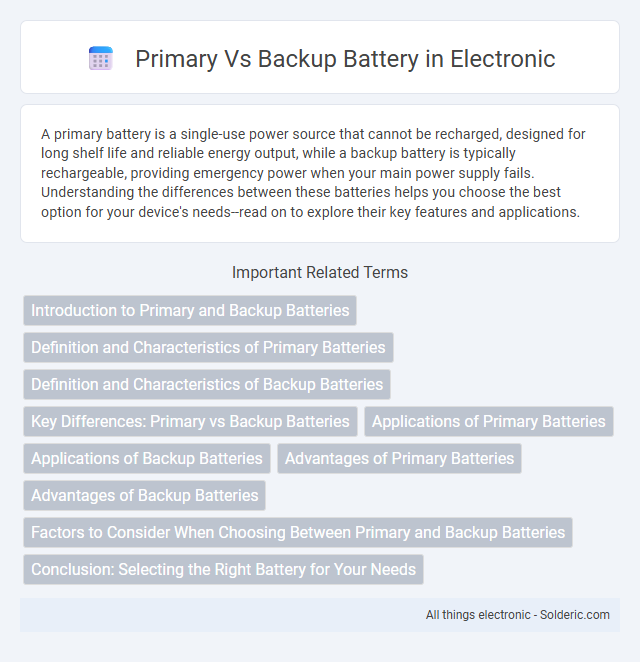A primary battery is a single-use power source that cannot be recharged, designed for long shelf life and reliable energy output, while a backup battery is typically rechargeable, providing emergency power when your main power supply fails. Understanding the differences between these batteries helps you choose the best option for your device's needs--read on to explore their key features and applications.
Comparison Table
| Feature | Primary Battery | Backup Battery |
|---|---|---|
| Purpose | Main power source for devices | Secondary power source during outages |
| Rechargeability | Non-rechargeable (disposable) | Rechargeable (usually) |
| Usage Duration | Limited to one-time use until drained | Designed for repeated use over long periods |
| Typical Applications | Remote controls, flashlights, toys | Uninterruptible Power Supplies (UPS), emergency systems |
| Cost | Lower upfront cost, multiple replacements needed | Higher upfront cost, long-term cost-effective |
| Energy Density | High energy density, optimized for single use | Moderate energy density, optimized for reliability |
| Maintenance | Minimal, replace when depleted | Requires periodic testing and charging |
Introduction to Primary and Backup Batteries
Primary batteries are single-use electrochemical cells that provide reliable power for devices until depleted, making them ideal for low-drain or infrequently used electronics. Backup batteries, often rechargeable, serve as a secondary power source to maintain device operation during primary power failure, ensuring data integrity and continuous performance. Both types are essential in various applications, with primary batteries favored for portability and backup batteries for critical power resilience.
Definition and Characteristics of Primary Batteries
Primary batteries are non-rechargeable electrochemical cells designed for single-use, converting stored chemical energy into electrical energy until depletion. They typically exhibit high energy density, long shelf life, and stable voltage output, making them ideal for low-drain or emergency devices such as remote controls and smoke detectors. Common primary battery chemistries include alkaline, zinc-carbon, and lithium, characterized by their reliable one-time use and inability to be recharged.
Definition and Characteristics of Backup Batteries
Backup batteries are secondary power sources designed to provide energy during primary power failures, ensuring continuity in critical applications such as data centers, medical devices, and communication systems. Unlike primary batteries, which are disposable and cannot be recharged, backup batteries are rechargeable and built for repeated cycling to maintain reliability over extended periods. Your choice of a backup battery depends on factors like capacity, recharge time, and durability, aiming to enhance system resilience and prevent data loss or operational downtime.
Key Differences: Primary vs Backup Batteries
Primary batteries are single-use power sources designed for long shelf life and high energy density, ideal for devices that require consistent, uninterrupted energy. Backup batteries, often rechargeable, serve as emergency power reserves to maintain functionality during primary power failures, ensuring your critical systems stay operational. The key differences lie in their usage patterns, with primary batteries optimized for disposable energy delivery and backup batteries tailored for repeated charge and discharge cycles.
Applications of Primary Batteries
Primary batteries are widely used in applications where long shelf life, low maintenance, and reliable single-use power are essential, such as remote controls, smoke detectors, and military equipment. These batteries excel in devices that require infrequent use but dependable energy availability, including emergency flashlights and medical devices like pacemakers. Your choice of a primary battery ensures consistent, disposable power without the need for recharging.
Applications of Backup Batteries
Backup batteries are essential for powering critical systems during outages, providing uninterrupted electricity in applications like data centers, medical equipment, and emergency lighting. These batteries ensure your devices maintain functionality in power failures, preventing data loss and maintaining safety. Industries such as telecommunications, security systems, and renewable energy storage rely heavily on backup batteries for reliable performance.
Advantages of Primary Batteries
Primary batteries offer a high energy density, making them ideal for devices requiring long-lasting, reliable power without the need for recharging. They feature a simple design with a low self-discharge rate, ensuring extended shelf life and readiness for use in emergency equipment and remote applications. Their lightweight nature and cost-effectiveness contribute to widespread use in low-drain electronics such as remote controls, flashlights, and smoke detectors.
Advantages of Backup Batteries
Backup batteries provide essential power during outages, ensuring your devices and systems remain operational without interruption. These batteries enhance reliability by offering a seamless transition from primary power sources, reducing downtime and protecting against data loss or system failure. Your setup benefits from increased resilience and peace of mind, especially in critical environments requiring constant power availability.
Factors to Consider When Choosing Between Primary and Backup Batteries
When choosing between primary and backup batteries, consider factors such as energy density, self-discharge rate, and lifespan, which influence performance and reliability. Primary batteries offer high energy density and long shelf life, ideal for low-drain or emergency use, while backup batteries provide rechargeable options for frequent use and cost efficiency. Your choice should align with the device's power requirements and maintenance preferences to ensure optimal functionality.
Conclusion: Selecting the Right Battery for Your Needs
Primary batteries offer long shelf life and reliable performance for low-drain devices, while backup batteries excel in critical applications requiring immediate power availability and rechargeability. Your choice depends on device energy demands, usage frequency, and maintenance preferences. Evaluating these factors ensures you select the right battery that balances cost, efficiency, and reliability.
Primary vs Backup battery Infographic

 solderic.com
solderic.com